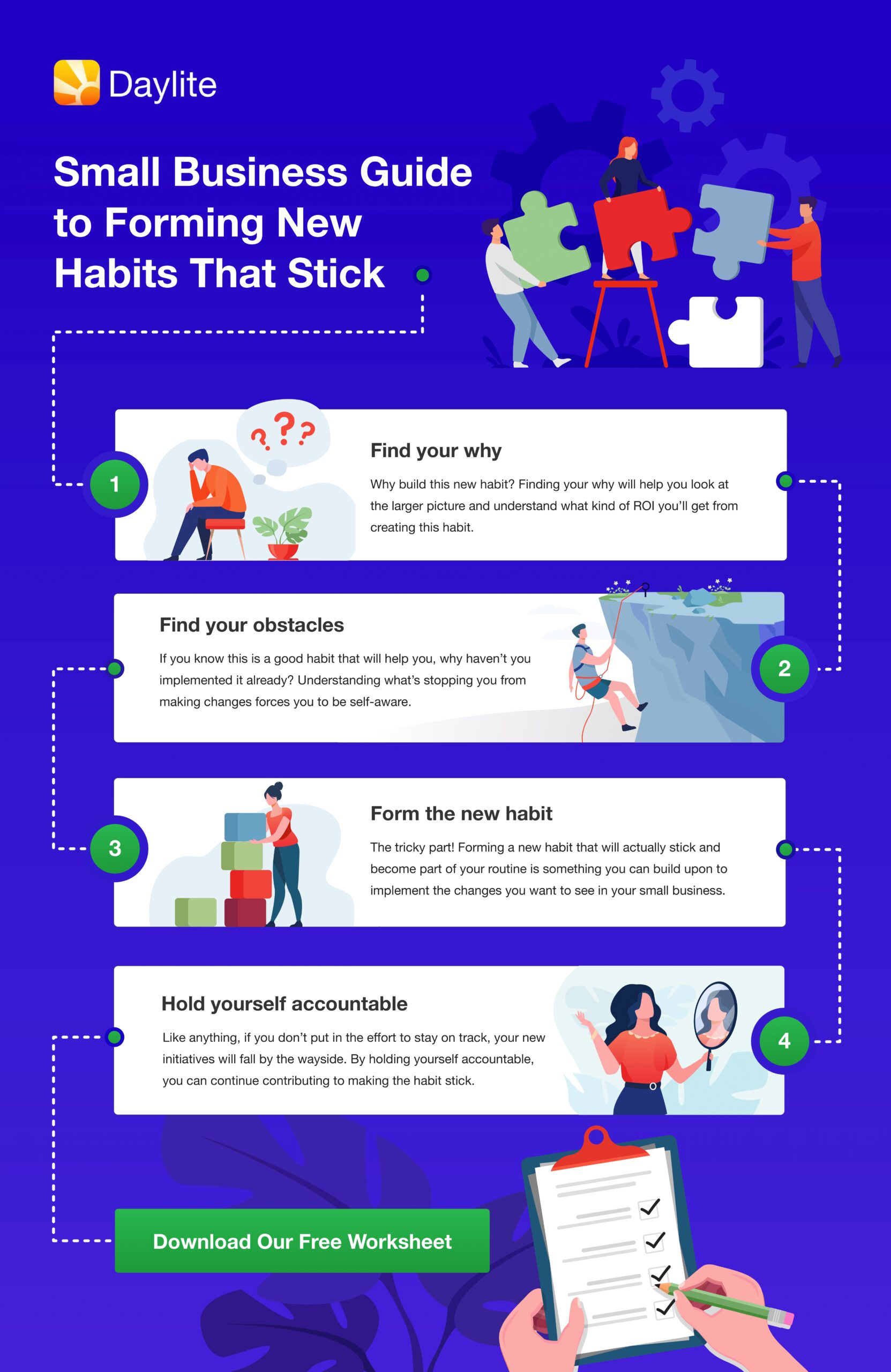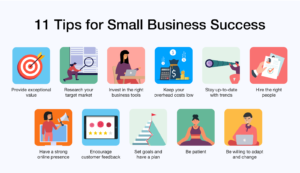You’ve heard of the saying, “Practice makes perfect.” Endless best practices to make your business run smoother, like tips about following up, tracking, lead generation, and time management. So why isn’t your small business running like a well-oiled machine?
Habits are hard to break, but even harder to build – every day is a summation of your habits. From brushing your teeth to checking your email, these ingrained behaviors you don’t even think about are the foundation of everything you do. And when it comes to overcoming obstacles for your small business success, building habits that stick is equally important.
In this blog, we will show you how you can hack your brain into creating new habits that will help you become a successful small business owner.
The 4-step strategy to building new habits stands as a cornerstone of personal and professional growth, and is used particularly by business owners. By implementing this strategy, you can cultivate habits that optimize time management, decision-making, and overall efficiency, ultimately helping you be a successful business owner.
The 4-step Strategy

An infographic containing the following:
- Find Your Why
- Find Your Obstacles
- Form the New Habit
- Fold Yourself Accountable
Download our free customizable worksheet with the 4-step strategy to building new habits that will bring consistent growth and success for your small business.
Step 1 – Find your Why
Why build this new habit? If you want to create new habits to become a successful business owner, finding your why will help you look at the larger picture and understand what kind of return on investment (ROI) you’ll get from creating this habit.
To start small, you can simply begin with just one realistic habit that you want to create. With the exercise below, you can find the reason why this is important to you and why it’s worth investing in.
Example:
New Habit: Track where leads are coming from
What goals will this help me achieve?
- Know where my leads are coming from
- Grow my business by 20%
- Have more work/life balance
- Hire a new employee
How?
- Tracking where leads are coming from will help me know what’s working
- I can invest in the right things to increase leads and grow my business
- More customers will increase revenue and let me hire a new employee, giving me more work/life balance
Step 2 – Find Your Obstacles
If nothing is stopping you from creating a new habit that you know will help your business, you would have done it already. Try the exercise below to find out what’s really holding you back from becoming a successful business owner, and list out the necessary actionable steps to overcome those obstacles in your small business.
Example:
New Habit: Track where leads are coming from
- Obstacle 1: “I don’t have time to do this”
- Action Item: “I can add this as a question on my site’s contact”
- Obstacle 2: “I can’t afford a new tool to track this”
- Action Item: “I can look at the existing tools I am using to see if this is already possible • I can track it in a spreadsheet for now”
- Obstacle 3: “I have to make too many changes to make this happen”
- Action Item: “I can set up a reminder or add it to my sales pipeline so it’s a mandatory step since I don’t have a contact form on my site”
Step 3 – Form the New Habit
Making a new habit part of your routine is often easier said than done, but by implementing the technique of habit stacking, you can create a new behavior by adding your new desired habit after an already well-established habit.
Habit stacking is something you already do without even thinking of it because it’s a logical way to complete tasks. For example, taking a shower, drying your hair, then combing it could be three habits you’ve already built into a routine. Because it’s logical, you don’t have to plan this out or overthink it, you just do it because it makes sense.
Habit stacking is so effective because it’s easy to follow. Just like a checklist, all you have to do is go through the motions as you check each step off the list.
Pro tip: Look at habits of successful business owners, especially in your industry, and look for consistencies. Ask yourself what is the one habit they all have in common, and try to implement that habit into your life.
To habit stack, follow this formula:
“After [established habit], I will [new habit]…”
Example: Using our previous example of tracking leads, we can look for the logical moment to add tracking the lead in our existing routine.
Our current sales pipeline includes an intake form that gets filled out when working with a new customer. Our first step is getting the customer’s contact information. By adding a section like “Where did you hear about us?” tracking where the leads came from is now a mandatory and logical step in the intake process.
Following the habit stacking formula, our new behaviour looks like this:
“After I get the contact information, I will ask where they heard about us.”
Remember: Keep it simple and allow for small wins. Forming new habits doesn’t have to be a major change. All you have to do is make small adjustments. Habit stacking is all about putting new habits on top of already well-established behaviors, making them stick faster and permanently.
Step 4 – Hold Yourself Accountable
While habit stacking makes it as easy and convenient as possible to build new behaviors into your routine, change still takes time, consistency, and discipline. This is where accountability comes in. So you’ve followed all the steps and you’re falling off track. Now what?
Automate It
There’s no need to make it harder on yourself – there are plenty of tools and apps that allow you to make your habit part of a process, pipeline, or schedule. Using technology is the most reliable way to make your habit a guarantee.
Example: Use Daylite to habit stack by creating recurring reminders or repeating tasks to help you keep up with your new habits.
Enjoy It
Checking something off your list can be incredibly satisfying – it makes you feel successful immediately, no matter how small the task! Find out what gives you that dopamine hit, whether it’s crossing something off a list, assigning a special color to completed tasks, or clicking “done,” make sure you’re enjoying yourself.
Example: You can change the color of tasks and appointments in Daylite according to the category. This may sound simple, but changing the color of an appointment or task to green after completed might work as a quick reward with immediate satisfaction. It always feels gratifying when you finish something, but commemorating it with an additional action, no matter how small, feels even better!
Measure It
Taking a look back at the progress you’ve made is another satisfying feeling you don’t want to miss out on. A visual representation of your progress is a perfect way to see the sum of your success, and it can even encourage you to avoid breaking a streak. It can be as simple as a calendar, habit tracker, or app you use daily.
Accountability
When building new habits, holding yourself accountable will be a guiding compass that moves you toward consistent progress. By being accountable, you’ll be able to put in that extra effort and remain consistent in building the new habit, even on days when your motivation is not at 100%. This practice not only reinforces your dedication but also reinforces a sense of ownership over your actions.
Find Your Strength
No one wants to do something they’re not good at. It’s discouraging and certainly not motivating. Create habits that are within your level of ability while still challenging so you don’t start getting bored. It’s easy to stay motivated when you’re excited about what you’re doing, but as time goes on and the routine becomes commonplace, this is when the real winners emerge. By giving yourself realistic tasks you know you can do but require more of your skillset, you’re giving yourself a much bigger chance of being successful.
Example: If the new habit you’re building is tracking where leads are coming from and you’re already a superstar at building rapport with your customers, use that skillset to find out where that customer heard about you. You’re already a pro at building relationships – so how can you use that talent to find out where your business is coming from?
Get Ready for Success
While good habits will certainly bring you better results, they will also, more importantly, teach you that all those things you thought you couldn’t do or improve were achievable all along. Small changes that might seem unimportant or negligible at first will snowball into some remarkable results if you really stick to them. Those small changes become small wins, and they compound over time!
Think of the habits you build now as an investment into the habits of successful business owners.
Wrapping Up
In the journey to build habits that stick, embrace the inevitable setbacks as opportunities to learn and recalibrate, rather than reasons to give up. By following the 4-step strategy of finding your why, finding your obstacles, forming new habits, and holding yourself accountable, you set the foundation for transformative change.
And to create an easily achievable plan using these strategies, download our free customizable worksheet.
About the author: Tucky Wong is Marketcircle’s Senior Marketing Manager. With a wealth of Marketing experience that spans nearly two decades, her expertise has become an invaluable asset in the world of small business empowerment as she’s the great mind behind impactful content and strategies. Tucky’s commitment to empowering small businesses ensures that every strategy and piece of content resonates with the spirit of growth and achievement.


